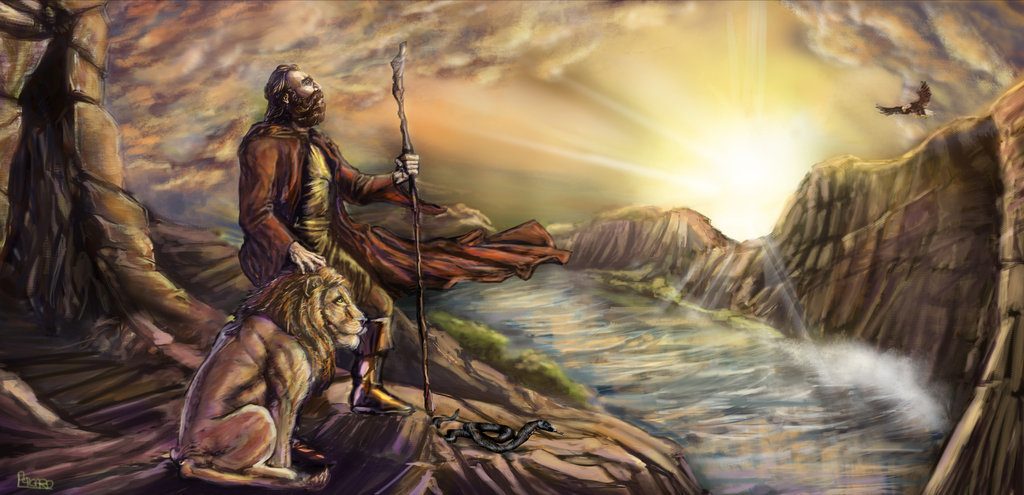Zoroastrianism was a dualist faith that originated in Persia, and over the years it has influenced a number of other faiths. Even though we may not recognize it today, it has been an influence on a number of world religions, especially on Christianity and Islam. Zoroastrianism is a belief system that stresses how we as human beings were meant to strive for our full potential. A primary tenet of the faith is that righteous and upstanding people will participate in the rewards of paradise, while the evil-doers will undergo punishments in hell.1
The prophet and founder of Zoroastrianism was Zarathustra, a man from an aristocratic family in Rhages, Media. Most scholars believe that Zarathustra was born around the late seventh and early sixth centuries B.C.E. He was a priest who became disillusioned with Persian ancestral religion, so instead he decided to search for inspiration and wisdom, and for a deeper meaning to life. After ten years of traveling, he finally realized that he had been called to be a prophet of Ahura Mazda, the Lord of Light. “He received a revelation in the form of the Avesta, the holy book of his religion, and commissioned to preach to humankind.”2 He would preach the Gathas; these were known as the hymns to the gods.
The central claim of Zoroastrianism is that there are two coequal and co-eternal gods: Ahura Mazda, the All-knowing Lord of Light, and Angra Mainyu or Ahriman, the Lord of Darkness. These gods represent an extreme dualism, where followers were given the option of choosing whom to worship. Ahura Mazda would save or condemn individuals based on whichever choice they decided to make.3 The people would experience rewards and punishments based on how they chose to behave. If they followed “Good words, Good thoughts, Good deeds,” they would be able to appreciate all the pleasures Ahura Mazda had in store for them in the afterlife.4

Devotees of Zoroastrianism believed that Ahura Mazda first produced the World of Thought and then gave birth to the World of the Living; but there was not yet life. Angra Mainyu challenged this pre-creation with his own counter-creation in order to destroy what Ahura Mazda was establishing. The Lord of Darkness wanted to demolish it with darkness, sickness, and death. Before Angra Mainyu was able to attack, Ahura Mazda forced him to recoil to the darkness. He was stunned into unconsciousness for three thousand years.5
Ahura Mazda then prepared for the Mixture of war, or battles against evil. This war was going to last six thousand years. For the first three thousand years, Ahura Mazda would unite with other lesser gods so that they could form a broad alliance. Angra Mainyu’s evil queen helped awaken the evil-doer and stirred all evil beings to attack Ahura Mazda. The battle then began, and Ahura Mazda’s creation came to life. Unfortunately, the very first beings killed were good, Gayomard and the Lone Bull; but from their semen they were able to manifest all humankind and bring into being all animals. Ahura Mazda’s right-hand man was Karsasp, a beautiful and innocent man, who helped fight off Angra Mainyu and his servants. Ahura Mazda then put Karsasp into a deep sleep so he would be well-rested for the very Last Battle.6 “At death, according to the tenets of Zoroastrianism, the souls of all persons ascend to the summit of Mount Hara where the good and bad of each soul are weighed in balances.”7 If one has made exceptional choices, ones soul will cross the cosmic bridge and continue an existence in heaven. In the case that many of one’s decisions were unacceptable, the bridge will disrupt and one’s soul will perish in hell. Scholar Charles David Isbell summarizes the eschatology of Zoroastrianism this way: “Since evil will have become extinct, history will come to an end, good souls will receive immortal bodies and will live forever in the re-perfected earth ruled over by Ahura-mazda.”8
This religion has continued to be practiced for as much as three thousand years. There are still a few thousand devotees that continue to carry on the traditions of Zoroastrianism in Iran and in India today. This religion has faced many difficulties in its long history, especially during the seventh century C.E. when invading Arab Muslims conquered the land of Persia, the homeland of Zoroastrianism. The conquerors chose not to take away this religion altogether, but they did choose to put a financial burden on the Zoroastrian temples.9 Many fled to India, which is home today to many of their descendants, known as Parsis. Many of those who stayed in Persia ended up converting to Islam. Although it may not be practiced as widely today, it has made a considerable impact on other religions.
Christianity was one of those religions that may have been influenced by elements within Zoroastrianism. Scholar John R. Hinnells writes,
It is generally held that the form of the later Jewish and Christian concept of the devil or Satan was influenced by Iranian tradition. If this be accepted then it has serious implications for the understanding of the saviour or Messianic figure…. When [the devil] becomes truly demonic … then the savior is given a new task.10
That task, Hinnells believes, was to defeat a supernatural and evil being, which taps into Zoroastrian dualism. In fact, the beliefs in a Satan of evil pitted against a God of good, the belief in angels and demons fighting a cosmic war, and the belief in a savior figure who would save all of humanity from evil and sin are all elements deriving from Zoroastrianism.11 Zoroastrianism in its original form may be an obscure faith in today’s society, but its impact on the fundamental principles of many religions is evident and deserves our appreciation and acknowledgement.
- Jerry Bentley, Herbert Ziegler, Heather Streets Salter, Traditions & Encounters: A Brief Global History Volume 1 (New York, NY: McGraw-Hill Publishers, 2016), 95-99. ↵
- Salem Press Biographical Encyclopedia, 2015, s.v. “Zoroaster,” by J. Steward Alverson. ↵
- Funk & Wagnalls New World Encyclopedia, 2016, s.v. “Ahura Mazda.” ↵
- Bentley, Ziegler, and Street Salter, Traditions & Encounters, 96-97. ↵
- P. Oktor Skjærvø, “Good vs. Evil,” Calliope 15, no. 5 (January 2005): 8. ↵
- P. Oktor Skjærvø, “Good vs. Evil,” Calliope 15, no. 5 (January 2005): 8. ↵
- Charles David Isbell, “Zoroastrianism and Biblical Religion,” Jewish Bible Quarterly (2006). ↵
- Charles David Isbell, “Zoroastrianism and Biblical Religion,” Jewish Bible Quarterly (2006). ↵
- Bentley, Ziegler, and Street Salter, Traditions & Encounters, 97-98. ↵
- John R. Hinnells, Zoroastrian and Parsi Studies: Selected Works of Johr R. Hinnells (Burlington, VT: Ashgate Publishing Co., 2000), 46. ↵
- Bryan Rennie, “Zoroastrianism: The Iranian Roots of Christianity,” The Council of Societies for the Study of Religion vol. 36 no. 1 (2007): 3-5. ↵



89 comments
Gabriella Parra
Great article! I’ve been intrigued by Zoroastrianism since high school when I learned of the commonalities between it and Christianity. It is easy to see that Zoroastrianism had a huge impact on Judaism and Christianity. It’s amazing that not many people know about it despite the influence it has had. I wonder what influenced Zarathustra himself. His religion seems very different from ancestral Persian practices.
Halie Estrada
This article was very enlightening because I have family and friends who are Christian. It’s so cool to see how their religion was influenced by another so many years before. I was always so skeptical on how Christianity got its good and evil teaching, but now I know that it was influenced from Zoroastrianism and his teachings. “That Righteous and upstanding people will participate in rewards of paradise, while evil-doers will undergo punishments in hell.” The more and more I read on ancient religions the more I understand how import it is that we preserve our religions, literacy, practices, political and economic ways so that we can continue to grow and evolve.
Seth Roen
First, I want to say a great article on such an unknown religion. One that influenced so many of the major religions today, with Zoroastrianism and the belief that choices made in life effects the afterlife. I do agree that Zoroastrianism deserves a greater recognization than it usually receives today. It being a rather ancient practice, and rich with tradition and history.
Emily Rodriguez
This was a very engaging and intriguing article to read. Prior to reading this, I had no true knowledge on Zoroastrianism and what it was about, nor the influence it might’ve had on “modern-day” religions such as Christianity. The article had an easy flow of a storyline and made something that could’ve seemed complex to understand, very simple. Overall, I found it very interesting to learn about the Lord of Light and the Lord of Darkness.
Aurora Torres
To be honest I have never heard of this religion until taking this history class and reading your article helps me to understand the Zoroastrianism religion. It is interesting that it is between good and evil and you must choose either. Doing good deeds brings you closer to getting to heaven. On reading the article I was thinking that this was some what close to some of Christianity believes, in other words we have free will in this life and it is up to us what we want to believe and do in this world. But interesting to read that “At death, according to the tenets of Zoroastrianism, the souls of all persons ascend to the summit of Mount Hara where the good and bad of each soul are weighed in balances.” That is crazy it is weighed and that depends on your journey to either heaven or hell. Also, even today some people still practice this religion I suppose they want to make their ancestors happy and keep this religion going knowing that it has not been forgotten.
Kayla Braxton-Young
I learned a lot from this article, and I would recommend to others to read this article so they can learn about Zoroastrianism. I liked how it had a lot of information and it focuses on the topic that we are talking about in class. I really found this article interesting, because it isn’t something that I know a lot about or even heard of. I really like how this article relates to what we are reading in class, which makes me get a better understanding of the reading.
Samuel Vega
Jezel, I was not familiar with Zoroastrianism and that the principles from this religion influenced Christianity. Your article describes the elements of Zoroastrianism with several references to the dualities such as light and darkness or good and evil. The duality is seen in Catholicism with a loving God and a tempting devil. Your summation of the article state “impact on the fundamental principles of many religions is evident and deserves our appreciation and acknowledgement.” I appreciate learning about Zoroastrianism and have a better understanding of this ancient religion and how it may have influenced some of the religions that are practiced today.
Enrico Zorzin Onzi
Hello Jezel. Very interesting and well written article. You were successful in drawing my attention to it. The fact that Zoroastrianism was a very popular religion originated in Persia, and throughout the years it has influenced other religions is very interesting to know, because reading the article, I realized the huge similarities it has regarding Christianism. In addition, every aspect of the human history is based on the creation of early civilizations, maybe in the future people will develop something based on the knowledge we have today, and so on. It surprised me that some people still practice Zoroastrianism in Iran and India today.
Joshua Marroquin
This article was very informative, and it helped me better understand the history of Zoroastrianism and the major impact it had on history and other religions. After reading this passage I learned things that I wouldn’t have never found out. It was a very interesting article that caused me to do more research in my own time so I can fully understand. I would recommend to others to read this passage so they can learn about Zoroastrianism and its history.
Robert Miller
I think the author of the article did a great job of summing up what was actually a very complicated belief. The part of the article that stands out the most to me is where the author cited a summarization by the Scholar Charles David Isbell. The line stated, “since evil will have become extinct, history will come to an end, good souls will receive immortal bodies and will live forever in the re-perfected earth ruled over by Ahura-Mazda”. I think that may refer to reincarnation.